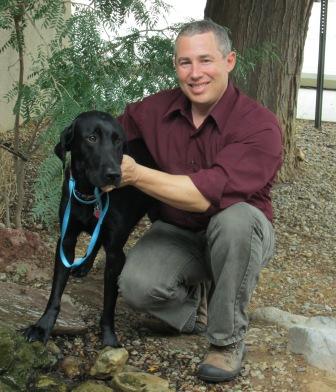Summer skin hazards: sun, heat, and bugs

JUST LIKE PEOPLE, lots of dogs (and some cats) really look forward to warm weather and blue skies. We all know about keeping our pets cool and well hydrated in the heat, but it’s important to keep their skin healthy as well. Here are some things to watch for as the sun gets hotter and the temperature gets warmer.
Most of this goes for both dogs and cats, but the numbers are higher for dogs because many of our cats stay safely indoors and tend to avoid direct sun in the heat of the day if they do go out. Cats also tend to have a denser coat, which protects parts of their body from UV damage.
The first problem is direct sun. It’s obvious, logical, but doesn’t always dawn on us till it’s too late. We live at 5,000 feet or higher of elevation, which puts us closer to the sun, and New Mexico is known for cloudless, sunny days—more than 310 of them per year. Add to that a dog with a very short, light-colored coat, and you have potential sun damage. White or pink skin is very susceptible and can get “pre-cancerous” lesions or sometimes malignant cancers.
Light-skinned or light-colored cats also are susceptible to sun damage, but usually on areas with less fur—the nose, tips of the ears, or sometimes the eyelids.
Be very careful if you have a dog with a thin coat and white skin who likes to sunbathe. Some do! Dalmatians, Boxers, Pit Bulls and their crosses are the ones we most commonly see at risk. Sometimes yellow Labradors and Rhodesian Ridgebacks belong to the sunbathing group. Make sure you provide lots of shade for them during the day.
If your dog likes to lie in the sun, you may have to take precautions, like keeping him indoors during the heat of day, or maybe using sunscreen. I have even suggested T-shirts for dogs who can’t stop sun worshipping. Please talk to your veterinarian if you think your dog or cat is at risk, and especially if you find changes in the skin that look like a problem.
In more rural or open parts of the city, we also have to worry about parasites. Most people know how to check for fleas and ticks, and there are lots of products on the market to help. But we have other bugs, too. Fly strike is a problem we see with dogs who spend the day outside, especially (but not always) around livestock. Flies bite the tips of the ears, generally in dogs whose ears stand away from the head (such as German Shepherds and Huskies). The dogs get really uncomfortable, and you’ll find crusts and/or scabs on the tips or edges of the ear flaps. This can be easily treated and prevented with fly repellent if you can’t bring the dogs inside.
Another problem pest is the Cuterebra larvae, or botfly. This large fly lays eggs at animal burrows, which then attach to the fur of any warm mammal that comes by. The larvae migrate through the body and emerge just under the skin, where they form a bump with a breathing hole.
They are not life-threatening unless they die or rupture under the skin, so have them removed very carefully by your vet. This is a common problem around Corrales, where we have open yards and lots of rabbits and other burrowing animals.
Go out and have fun this summer! Check your pets thoroughly for lumps or bumps, and if any seem abnormal to you, don’t hesitate to bring them to your veterinarian’s attention. A quick response often results in a better outcome!
Daniel Levenson operates the Southwest Veterinary Medical Center at the south end of Corrales Road. Visit his website at mysouthwestvet.com
